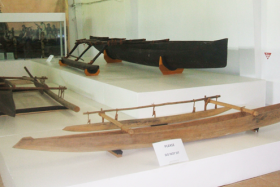A Review of Fiji Museums
Located in the heart of Thurston Gardens, Fiji museums form part of the Islands rich historical and anthropological collections. With its history dating back to 1904 with a donation by Sir William Alladyce to the Suva Town board. The museums have continuously made collection from the community that date back to over 3,700 years. This is further enhanced by beautiful art collections that are a creation of the locals giving a rich cultural heritage that is bound to give enticing and rich cultural prominence of the island.
The Historic Gallery
On a visit to the Fiji museums you are taken through the historic galley of the island. This dates back to the era of western awareness of Fiji islands that was around the years of 1643, the beche-de-mer, copra and sandalwood traders whose arrival was between 1800 – 1850. The colonials and indentured labor of 1879 – 1920 is also featured in the museums. Also featured in the museums are the remains of the sole of Rev. Bakers boots. This was the first non-Fijian missionary who was killed and eaten. The famous mutiny of 1789 is also featured greatly whose remains were recovered in 1932. Of the great things on display is the Deed of cessation copy that was signed when Fiji was colonized by the Britons. There are also medals of some of the great statesmen of Fuji and the remains of the vessel that was used to ferry indentured labors to Fiji.
Temporary Exhibition Space
 The collections found in Fiji museums increase by day. From creations by the locals to the ever-newfound artifacts renders the space available to be limited. It is for this reason that the management of the museums have in place a temporary exhibition space. This offers a space that is used on rotational basis where different items are on exhibition at varying seasons. It is for this reason that when interested in a certain category of exhibits there is need to contact the museums to get an outline of the upcoming exhibitions and thus enabling one to choose the most appropriate time to visit. This temporary exhibition space also offers a chance for those willing to have their creations exhibited by the museum.
The collections found in Fiji museums increase by day. From creations by the locals to the ever-newfound artifacts renders the space available to be limited. It is for this reason that the management of the museums have in place a temporary exhibition space. This offers a space that is used on rotational basis where different items are on exhibition at varying seasons. It is for this reason that when interested in a certain category of exhibits there is need to contact the museums to get an outline of the upcoming exhibitions and thus enabling one to choose the most appropriate time to visit. This temporary exhibition space also offers a chance for those willing to have their creations exhibited by the museum.
The Masi Gallery
Created with the intent to offer an insight to culture and tradition, masi gallery offers a collection of historical collections as well as amazing collections that can be acquired. Masi is a type of cloth that was created by beating the bark of paper mulberry tree. The resulting fabric was used in creation of fabrics that was used in clothing’s, worship, warfare and ceremonial duties. In modern times, the garments are still used or important marriages and funeral services alongside other decorative items that are sold to visitors of the museums.
The Indo-Fijian Gallery
In the years between 1879 and 1920, 60,000 Indians were brought to Fiji under a five years servitude agreement. Referred to as the girmit, they also form part of the history of the Fijian community. After this period, two thirds of the Indians remained in Fiji and their descendants remain as part of the population. It is the Indo-Fijian gallery that carries the collection of this historic moment that defines the moments of indentured labor and the customs and traditions they brought along.
The Art Gallery
The history of the Fijians is riddled with extensive works of art. These are displayed in the art gallery that comprises the works of professionals as well as armatures. It is in this part o the Fiji museums that the items exhibited can be purchased. This area of the exhibition is open for use by all through arrangements by the management. Of importance to note is that the exhibits are available for a defined period to give room for new ones.
Conclusion
With a wide range of items on display, the Fijian museums are a result of collections that depict culture, traditions, politics and religion of the Fiji people. In this regard it is an important place to visit for those willing to learn more on the Fijians. Owing to its diversity, the museum offer the visitors guidance and learning material on the various exhibits available. In such a way, visitors are able to choose the most appropriate areas of interest thereby saving on time and giving more convenience.
Learn More About Fiji
Recent Posts

Exotic Fiji private transfers: is it worth it?
Whether you are a corporate traveler, in Fiji f...
3 Tips for Planning a Vacation in Fiji
Fiji is one of the top vacation destinations in...
5 health benefits of a fiji island vacation
A Fiji island vacation can do wonders for not j...
Eco Tourism in Fiji: Save the Planet While You Vacation
Our planet is a living, breathing, ecosystem. I...
Captain Cook and the HMS Endeavor. Fijian History found in Rhode Island
Many of you may remember from school the storie...

